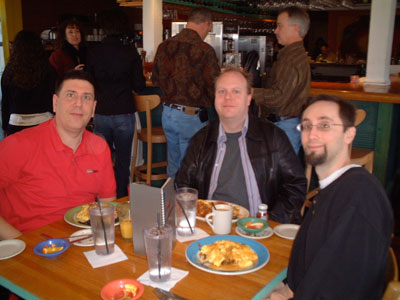Since we at OpenNMS don’t put any “phone home” code in our software, it is sometimes hard to tell who uses it and even if they like it. So when I travel I like to meet up with any users in the area (OpenNMS users are always incredibly intelligent, stunningly attractive and possessing a rapier-like wit). With both archon~ and derrick from the IRC channel in the Austin area, as well as Coté, I decided to try and set up a brunch in Austin before I had to head for San Antonio.
The first goal was to determine a place. It was up in the air as late as yesterday afternoon, when a chance meeting provided both a suggestion and an interesting conversation.
When I was on the barcampESM monitoring panel, I noticed that a woman had arrived and was busily snapping pictures. This was odd enough, since, to begin with, there were more cameras there than at a Britney Spears court appearance, and the fact that she was, well, a she, made her stand out. She left before I could find out who she was (and I was curious as to where those pictures were going to end up) but later when I was drinking the new Shiner Black Lager (yum), she returned and I was able to introduce myself.
Her name is Michelle Greer, and she’s involved in Geek Austin which is how she knows whurley and why she was there taking pictures. Geek Austin seems to be similar to Triangle InterNetWorkers in my area. She seems to know Austin pretty well, and she recommended Z Tejas as a nice place for lunch. It was a couple of blocks west of where the barcamp was held, so based on her recommendation and the fact that I could find it I decided to hold the OpenNMS Austin Brunch there.
Frank Sheiness (~archon from the #opennms IRC channel) and Chris Bowman were in, and I invited Coté as well, but I had the feeling that he had probably reached his limit of “Tarus Time” for the weekend. Derrick from IRC was going to show up, but he had some delayed and cancelled flights coming back from Florida and didn’t make it home until well after midnight.

Me, Chris and Frank at Z Tejas
I got to learn a lot more about Frank and Chris’s company, Korcett. They provide broadband services to apartment complexes, and they chose OpenNMS as their management tool.
I asked them how many devices they were monitoring, and the answer was less than 50. This surprised me, since the learning curve for OpenNMS is rather steep, and usually people with smaller networks don’t have or take the time to learn it. So I had to ask “Why OpenNMS?”.
There was the usual reason of scalability. The network is small now but they hope it will be growing rapidly, and it is easier to get things right at this stage than to try and fit it in later. But they also said that of all the solutions they looked at (and they looked at all of them), OpenNMS was the most “open”. It wasn’t in the sense that OpenNMS is truly free and open source, but that OpenNMS doesn’t force you into a particular way of management. It enabled them to configure the system to manage their network the way they wanted to, and not the way some vendor thought they should.
It warmed my heart.
I travel too much. I missed the snow back home, I miss my wife, and I’m now in yet another hotel room. But it’s meetings like today that make it all worthwhile.
In general, phone home stuff is bad. Even so, I almost always install and activate Debian’s popularity-contest package, which sends them information about what’s installed.
I think a similar feature for OpenNMS is not a bad idea, but I’d only be comfortable enabling it if your company followed rules like what I’ve just thought up below:
*) Only include non-identifying information such as version, OS, and information about the number and type of data points being monitored. Their IP address can naturally give you a wealth of information about them, but if you state your intention never to exploit it commercially, that’s not a big problem.
*) Never use the information as a marketing or sales tool. Strongly consider making the information available to the public in a condensed form. In that version, translate IP addresses into vague geographic regions.
*) One or more of the log files should clearly state when the phone home occurs and what information is being transmitted. This should happen no matter what logging level has been configured.
*) Make the process of enabling it just difficult enough that it must be very deliberately done.
I like this idea. I think we could even get away with not using the IP address if we grabbed the timestamp the “phone home” package was installed and the time zone and used that as the “identifier”.